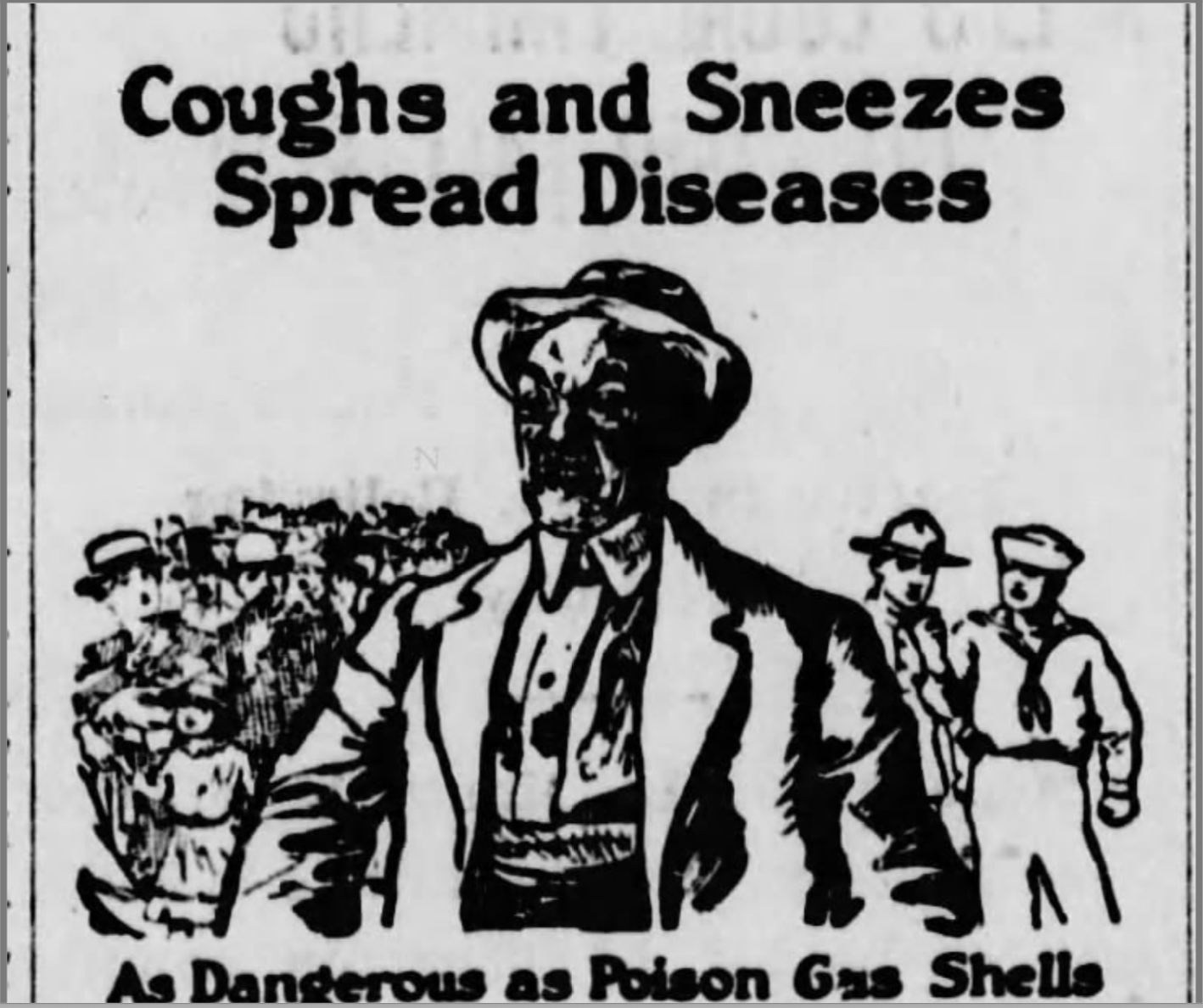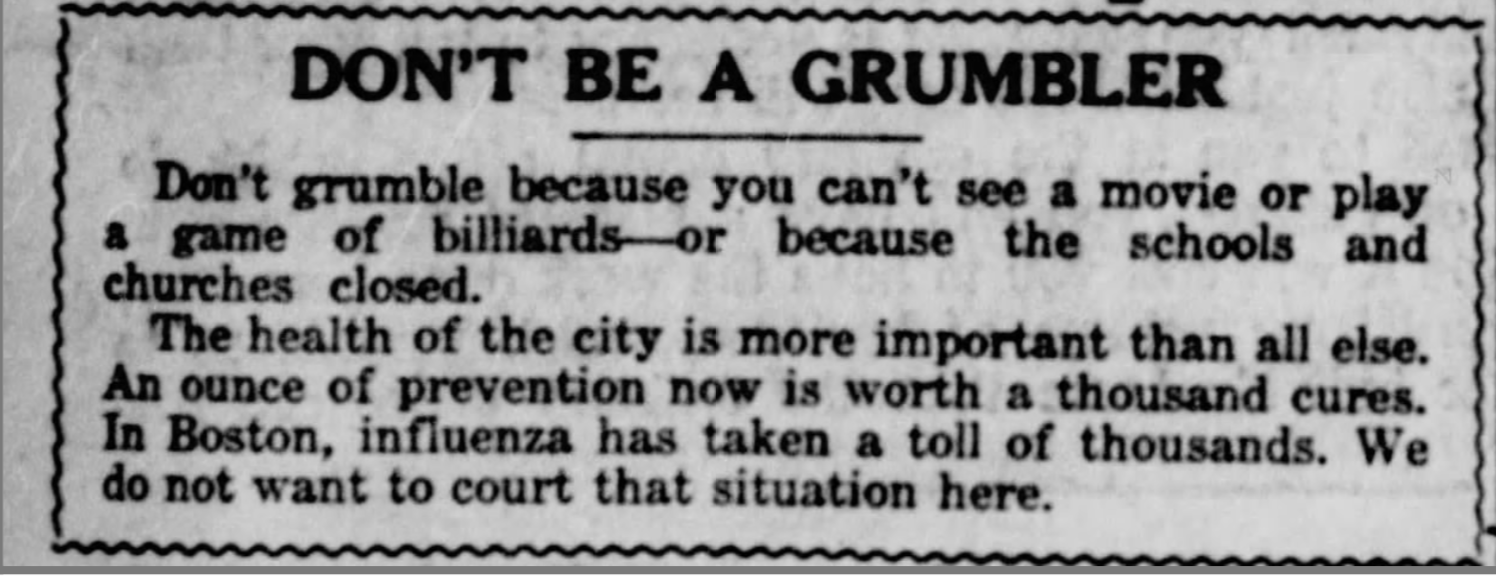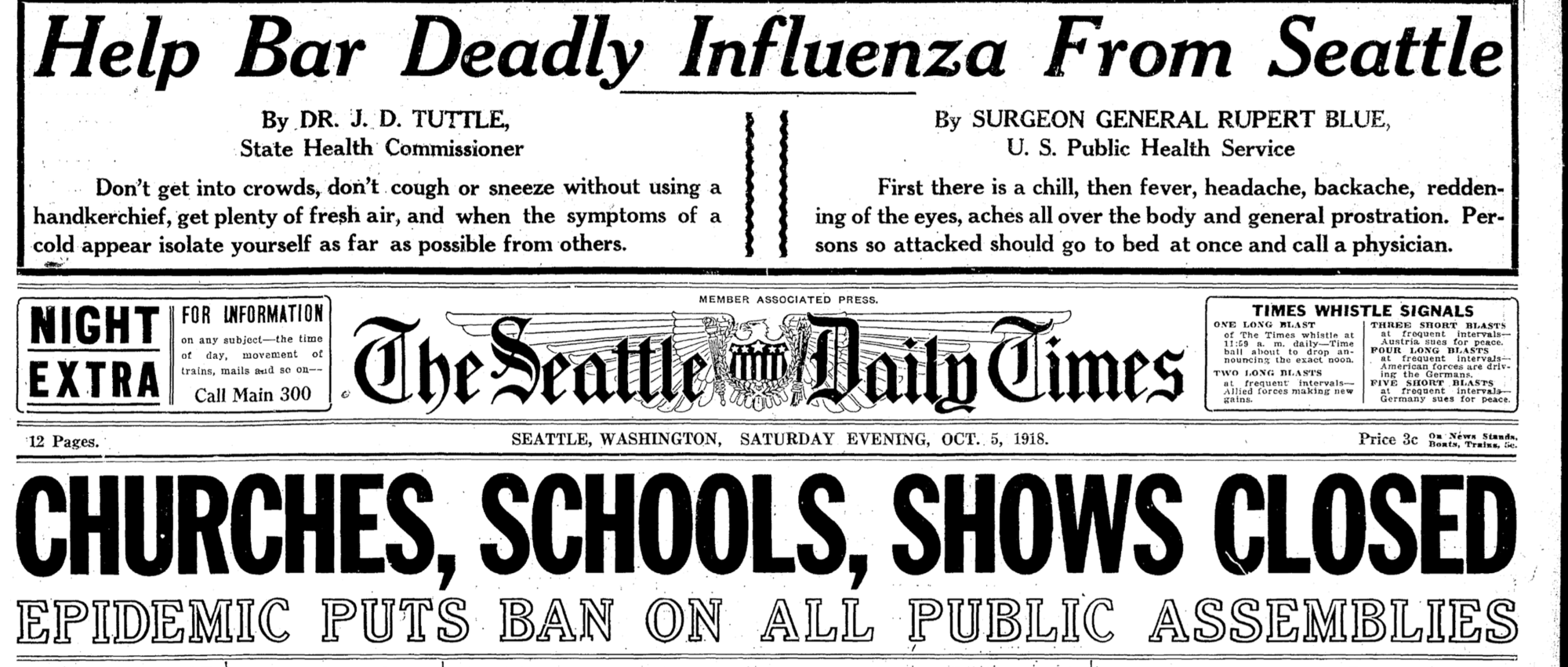Some referred to the pandemic as fighting “germs and Germans.” A newspaper caption in a Spokane paper claimed the flu was as “dangerous as poison gas shells.”
The so-called Spanish flu (which very likely started in Kansas and certainly did not begin in Spain) first spread through crowded and unsanitary military camps and naval ships. It soon infected civilian populations in large Eastern cities, like Boston and Philadelphia, and then made its way west. The deadly pathogen appears to have reached Puget Sound through a Navy vessel that arrived at the Bremerton Naval Training Station with 1,500 men from Philadelphia, many of whom were sick with influenza by the time they arrived. Eleven had to be carried off the ship on stretchers. According to John M. Barry’s history of the outbreak, The Great Influenza, the ship’s docking signaled the arrival of the disease on the Pacific Coast. State health authorities concluded the virus spread via multiple vectors, but the Navy ship was the most significant and traceable source.
For more on the Pacific Northwest's last pandemic experience, see Crosscut's entire series on the 1918 flu outbreak.
- Before coronavirus: How Seattle handled the Spanish flu
- Shady landlords and bootleggers ruled Seattle's last pandemic
- Meet the Anthony Fauci of 1918 Washington
- Seattle struggled with suicide in late stages of the 1918 flu
- Podcast: What the 1918 flu can tell us about life after COVID-19
The arrival of Spanish flu on the West Coast forced health officials to confront the same crisis we’re dealing with today: How do you keep a virulent new disease from spreading?
Social isolation and quarantine were options. So was shutting down all unnecessary activity, save activity that aided the war effort and kept the economy going. Puget Sound and its ports provided ships, planes, men and raw materials. The state’s biennial report from the Board of Health, which offered a description of the very earliest phase of Washington’s response to the flu pandemic, quoted an unidentified health officer saying, "One can avoid contracting the disease if he will go into a hole and stay there, but the question is how long would he have to stay there?” Isolation works, in other words, but how much isolation is realistic?

Quarantine was hard to maintain, but Seattle quickly learned that shutting down the city helped. The benefit was almost visible in real time.
After early disagreements about whether the flu that was spreading was in fact that plain old-fashioned flu or something new, health officials decided that the bad East Coast bug had to be stopped and a fire line built. Seattle could learn from what worked, and didn’t, in other cities.
The first cases were noted here in late September. By early October of 1918, Seattle shut its schools, banned public gatherings and closed churches and theaters and some sporting events, a version of our present “stay-at-home” order. Key businesses and other necessary activities carried on. The ban lasted about six weeks, then was eased as influenza cases and deaths appeared to slow.
But premature optimism seems to be characteristic of pandemics. First, authorities were in denial that local cases were the Spanish flu. Then, they believed it could be defeated too quickly.
When the isolation rules were relaxed, a second wave hit. More socializing and contact caused a rise in sickness and death. The spread also seemed to be tied to public gatherings or holidays — the street celebrations at the World War I armistice, in November, which officials could not prevent, followed by Thanksgiving and another spike just after Christmas and New Year’s. There was skepticism about containment, too. Quarantine seemed to work better in some cities than others. The public health official who posed the question about how long one would need to stay in a hole guessed it would be at least a year. In other words: not sustainable.
When the 1918 shutdown order for Seattle first went into effect, people didn’t adhere to it. Police had to break up gatherings in soda parlors and billiard rooms. People were ordered to wear masks in public; if they didn’t, they were not allowed on transit.
People complained about limitations to their movements and on public entertainment. Anticipating that, the Seattle Star newspaper ran a story about the new rules, with an above-the-fold box admonishing: “Don’t Be a Grumbler.”

It went on, “Don’t grumble because you can’t see a movie or play a game of billiards — or because the schools and churches are closed. The health of the city is more important than all else. An ounce of prevention now is worth a thousand cures. In Boston, influenza has taken a toll of thousands. We do not want to court that situation here.”
“Here” was not the only place of concern. There were similar shutdowns of greater or lesser severity across the state. Spokane, Tacoma, Olympia, Walla Walla and Yakima are among the cities that took measures. The influenza pathogens infiltrated the most remote rural towns in farm country and even remote fur-trapping country.
The disease, which also spread to villages and towns in Canada and Alaska, seemed to defy medical logic. Consider the story of how it arrived in Nome, Alaska, a fascinating case that showed how little people understood about the new disease. A steamship company that plied between Seattle and Nome knew that the Alaska town was so far free of influenza, and it had passengers who wanted to go there. So it went. The company hired doctors to screen, more than once, every single passenger and rejected any that had even the mildest of symptoms. Those inspected and deemed healthy went aboard. Once in Nome, they were held in isolation for five days, and the mail that the boat carried was fumigated for 10 hours before being handed on.
And yet the measures didn’t work; an outbreak in Nome soon followed and spread to “Eskimo” villages. Local health officials realized that asymptomatic carriers were spreading the disease. Plus, officials were not necessarily using all the efforts we now take — no mention was made of sanitizing the ship, and passengers were usually packed into such vessels. When the steamship returned to Seattle, it carried 150 passengers suffering from the Spanish flu. At the time, there was no testing that could determine who had the disease or immunity, who was a carrier or not. They realized you didn’t have to be coughing to kill.
The lesson from history is that helping people find a “hole” to hide in for a while can help prevent more people from getting sick. But the impulse to ignore what you can’t see is strong and, during a pandemic, can lead to life-threatening consequences.
When can we come out of our holes? The more we learn about the disease, and the more people sit still in the meantime, the sooner it will likely be.



